air condition SUBARU IMPREZA 2006 2.G Owners Manual
[x] Cancel search | Manufacturer: SUBARU, Model Year: 2006, Model line: IMPREZA, Model: SUBARU IMPREZA 2006 2.GPages: 365, PDF Size: 7.09 MB
Page 1 of 365
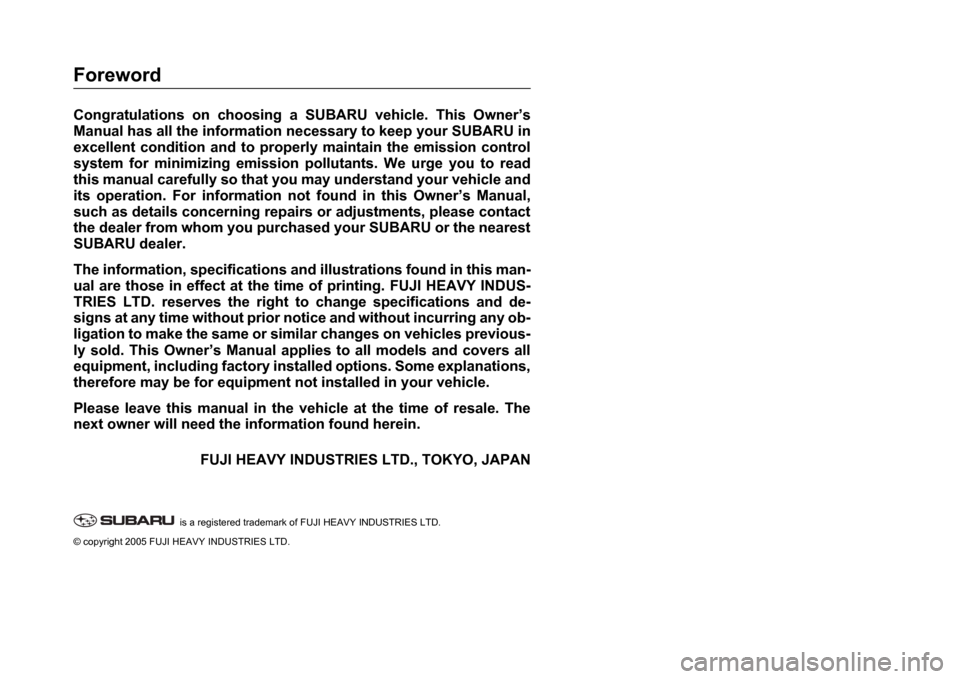
Foreword
Congratulations on choosing a SUBARU vehicle. This Owners
Manual has all the information necessary to keep yo ur SUBARU in
excellent condition and to properly maintain the em ission control
system for minimizing emission pollutants. We urge y ou to read
this manual carefully so that you may understand yo ur vehicle and
its operation. For information not found in this Ow ners Manual,
such as details concerning repairs or adjustments, please contact
the dealer from whom you purchased your SUBARU or t he nearest
SUBARU dealer.
The information, specifications and illustrations f ound in this man-
ual are those in effect at the time of printing. FU JI HEAVY INDUS-
TRIES LTD. reserves the right to change specificati ons and de-
signs at any time without prior notice and without incurring any ob-
ligation to make the same or similar changes on veh icles previous-
ly sold. This Owner s Manual applies to all models and covers all
equipment, including factory installed options. Som e explanations,
therefore may be for equipment not installed in you r vehicle.
Please leave this manual in the vehicle at the time of resale. The
next owner will need the information found herein.
FUJI HEAVY INDUSTRIES LTD., TOKYO, JAPAN
is a registered trademark of FUJI HEAVY INDUSTRIES LTD.
© copyright 2005 FUJI HEAVY INDUSTRIES LTD.
Page 9 of 365

6
Carefully read the sections Child restraint
systems , *SRS airbag (Supplemental
Restraint System airbag) , and Seatbelts
in chapter 1 of this owner s manual for in-
structions and precautions concerning the
child restraint system, seatbelt system
and SRS airbag system.
Engine exhaust gas (Carbon
monoxide)
Drinking and driving
Drunken driving is one of the most fre-
quent causes of accidents. Since alcohol
affects all people differently, you may
have consumed too much alcohol to drive
safely even if the level of alcohol in your
blood is below the legal limit. The safest
thing you can do is never drink and drive.
However if you have no choice but to
drive, stop drinking and sober up com-
pletely before getting behind the wheel.
Never inhale engine exhaust gas.
Engine exhaust gas contains car-
bon monoxide, a colorless and
odorless gas which is dangerous,
or even lethal, if inhaled.
Always properly maintain the en-
gine exhaust system to prevent
engine exhaust gas from entering
the vehicle.
Never run the engine in a closed
space, such as a garage, except
for the brief time needed to drive
the vehicle in or out of it.
Avoid remaining in a parked vehi-
cle for a lengthy time while the en-
gine is running. If that is unavoid-
able, then use the ventilation fan
to force fresh air into the vehicle.
Always keep the front ventilator
inlet grille free from snow, leaves
or other obstructions to ensure
that the ventilation system always
works properly.
If at any time you suspect that ex-
haust fumes are entering the vehi-
cle, have the problem checked
and corrected as soon as possi-
ble. If you must drive under these
conditions, drive only with all win-
dows fully open.
Keep the trunk lid or rear gate
closed while driving to prevent ex-
haust gas from entering the vehi-
cle.
Drinking and then driving is very
dangerous. Alcohol in the blood-
stream delays your reaction and im-
pairs your perception, judgment and
attentiveness. If you drive after
drinking even if you drink just a lit-
tle it will increase the risk of being
involved in a serious or fatal acci-
dent, injuring or killing yourself,
your passengers and others. In ad-
dition, if you are injured in the acci-
dent, alcohol may increase the se-
verity of that injury.
Please don t drink and drive.
Page 10 of 365
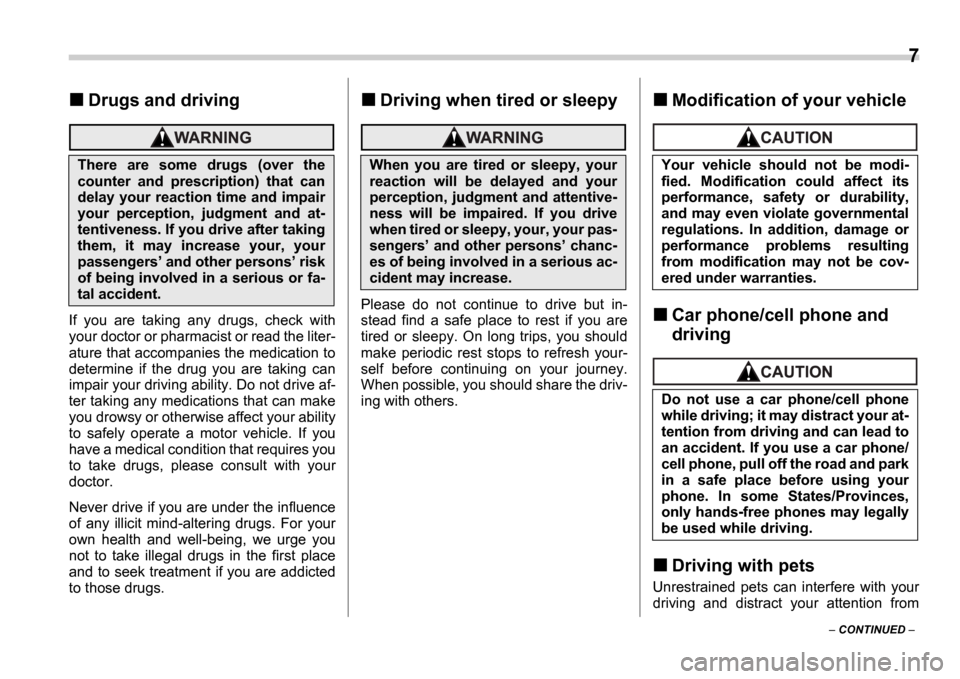
7
CONTINUED
Drugs and driving
If you are taking any drugs, check with
your doctor or pharmacist or read the liter-
ature that accompanies the medication to
determine if the drug you are taking can
impair your driving ability. Do not drive af-
ter taking any medications that can make
you drowsy or otherwise affect your ability
to safely operate a motor vehicle. If you
have a medical condition that requires you
to take drugs, please consult with your
doctor.
Never drive if you are under the influence
of any illicit mind-altering drugs. For your
own health and well-being, we urge you
not to take illegal drugs in the first place
and to seek treatment if you are addicted
to those drugs.
Driving when tired or sleepy
Please do not continue to drive but in-
stead find a safe place to rest if you are
tired or sleepy. On long trips, you should
make periodic rest stops to refresh your-
self before continuing on your journey.
When possible, you should share the driv-
ing with others.
Modification of your vehicle
Car phone/cell phone and
driving
Driving with pets
Unrestrained pets can interfere with your
driving and distract your attention from
There are some drugs (over the
counter and prescription) that can
delay your reaction time and impair
your perception, judgment and at-
tentiveness. If you drive after taking
them, it may increase your, your
passengers and other persons risk
of being involved in a serious or fa-
tal accident.When you are tired or sleepy, your
reaction will be delayed and your
perception, judgment and attentive-
ness will be impaired. If you drive
when tired or sleepy, your, your pas-
sengers and other persons chanc-
es of being involved in a serious ac-
cident may increase.Your vehicle should not be modi-
fied. Modification could affect its
performance, safety or durability,
and may even violate governmental
regulations. In addition, damage or
performance problems resulting
from modification may not be cov-
ered under warranties.
Do not use a car phone/cell phone
while driving; it may distract your at-
tention from driving and can lead to
an accident. If you use a car phone/
cell phone, pull off the road and park
in a safe place before using your
phone. In some States/Provinces,
only hands-free phones may legally
be used while driving.
Page 48 of 365
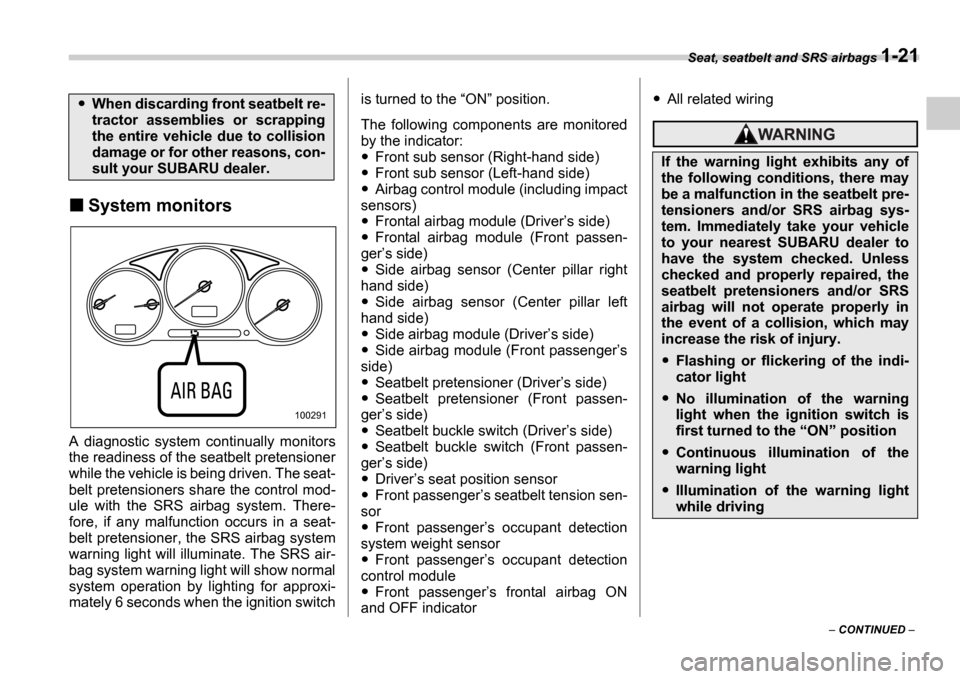
Seat, seatbelt and SRS airbags 1-21
CONTINUED
System monitors
A diagnostic system continually monitors
the readiness of the seatbelt pretensioner
while the vehicle is being driven. The seat-
belt pretensioners share the control mod-
ule with the SRS airbag system. There-
fore, if any malfunction occurs in a seat-
belt pretensioner, the SRS airbag system
warning light will illuminate. The SRS air-
bag system warning light will show normal
system operation by lighting for approxi-
mately 6 seconds when the ignition switch is turned to the
ON position.
The following components are monitored
by the indicator:
Front sub sensor (Right-hand side)
Front sub sensor (Left-hand side)
Airbag control module (including impact
sensors)
Frontal airbag module (Driver s side)
Frontal airbag module (Front passen-
ger s side)
Side airbag sensor (Center pillar right
hand side)
Side airbag sensor (Center pillar left
hand side)
Side airbag module (Driver s side)
Side airbag module (Front passenger s
side)
Seatbelt pretensioner (Driver s side)
Seatbelt pretensioner (Front passen-
ger s side)
Seatbelt buckle switch (Driver s side)
Seatbelt buckle switch (Front passen-
ger s side)
Driver s seat position sensor
Front passenger s seatbelt tension sen-
sor
Front passenger s occupant detection
system weight sensor
Front passenger s occupant detection
control module
Front passenger s frontal airbag ON
and OFF indicator
All related wiringWhen discarding front seatbelt re-
tractor assemblies or scrapping
the entire vehicle due to collision
damage or for other reasons, con-
sult your SUBARU dealer.
100291
If the warning light exhibits any of
the following conditions, there may
be a malfunction in the seatbelt pre-
tensioners and/or SRS airbag sys-
tem. Immediately take your vehicle
to your nearest SUBARU dealer to
have the system checked. Unless
checked and properly repaired, the
seatbelt pretensioners and/or SRS
airbag will not operate properly in
the event of a collision, which may
increase the risk of injury.
Flashing or flickering of the indi-
cator light
No illumination of the warning
light when the ignition switch is
first turned to the ON position
Continuous illumination of the
warning light
Illumination of the warning light
while driving
Page 70 of 365
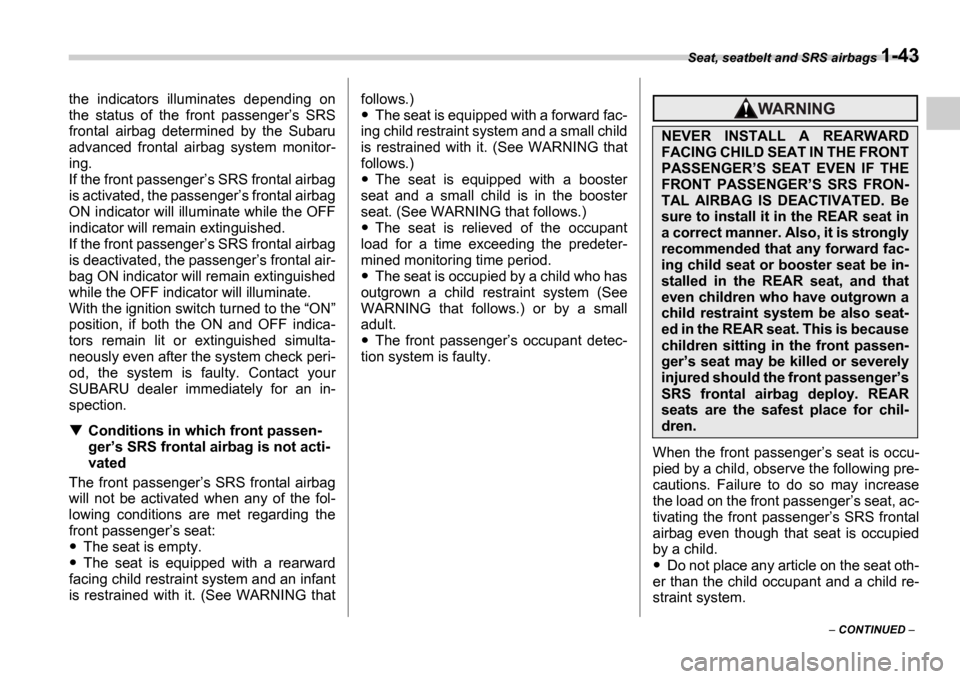
Seat, seatbelt and SRS airbags 1-43
CONTINUED
the indicators illuminates depending on
the status of the front passenger
s SRS
frontal airbag determined by the Subaru
advanced frontal airbag system monitor-
ing.
If the front passenger s SRS frontal airbag
is activated, the passenger s frontal airbag
ON indicator will illuminate while the OFF
indicator will remain extinguished.
If the front passenger s SRS frontal airbag
is deactivated, the passenger s frontal air-
bag ON indicator will remain extinguished
while the OFF indicator will illuminate.
With the ignition switch turned to the ON
position, if both the ON and OFF indica-
tors remain lit or extinguished simulta-
neously even after the system check peri-
od, the system is faulty. Contact your
SUBARU dealer immediately for an in-
spection.
Conditions in which front passen-
ger s SRS frontal airbag is not acti-
vated
The front passenger s SRS frontal airbag
will not be activated when any of the fol-
lowing conditions are met regarding the
front passenger s seat:
The seat is empty.
The seat is equipped with a rearward
facing child restraint system and an infant
is restrained with it. (See WARNING that follows.)
The seat is equipped with a forward fac-
ing child restraint system and a small child
is restrained with it. (See WARNING that
follows.)
The seat is equipped with a booster
seat and a small child is in the booster
seat. (See WARNING that follows.)
The seat is relieved of the occupant
load for a time exceeding the predeter-
mined monitoring time period.
The seat is occupied by a child who has
outgrown a child restraint system (See
WARNING that follows.) or by a small
adult.
The front passenger s occupant detec-
tion system is faulty.
When the front passenger s seat is occu-
pied by a child, observe the following pre-
cautions. Failure to do so may increase
the load on the front passenger s seat, ac-
tivating the front passenger s SRS frontal
airbag even though that seat is occupied
by a child.
Do not place any article on the seat oth-
er than the child occupant and a child re-
straint system.
NEVER INSTALL A REARWARD
FACING CHILD SEAT IN THE FRONT
PASSENGER S SEAT EVEN IF THE
FRONT PASSENGER S SRS FRON-
TAL AIRBAG IS DEACTIVATED. Be
sure to install it in the REAR seat in
a correct manner. Also, it is strongly
recommended that any forward fac-
ing child seat or booster seat be in-
stalled in the REAR seat, and that
even children who have outgrown a
child restraint system be also seat-
ed in the REAR seat. This is because
children sitting in the front passen-
ger s seat may be killed or severely
injured should the front passenger s
SRS frontal airbag deploy. REAR
seats are the safest place for chil-
dren.
Page 71 of 365
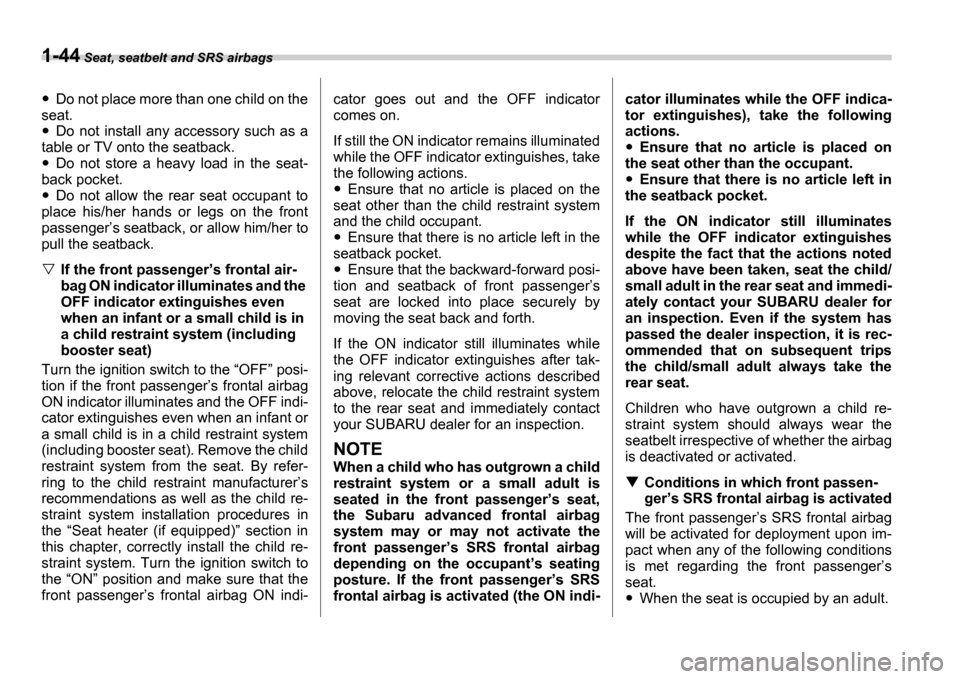
1-44 Seat, seatbelt and SRS airbags
Do not place more than one child on the
seat.
Do not install any accessory such as a
table or TV onto the seatback.
Do not store a heavy load in the seat-
back pocket.
Do not allow the rear seat occupant to
place his/her hands or legs on the front
passenger s seatback, or allow him/her to
pull the seatback.
If the front passenger s frontal air-
bag ON indicator illuminates and the
OFF indicator extinguishes even
when an infant or a small child is in
a child restraint system (including
booster seat)
Turn the ignition switch to the OFF posi-
tion if the front passenger s frontal airbag
ON indicator illuminates and the OFF indi-
cator extinguishes even when an infant or
a small child is in a child restraint system
(including booster seat). Remove the child
restraint system from the seat. By refer-
ring to the child restraint manufacturer s
recommendations as well as the child re-
straint system installation procedures in
the Seat heater (if equipped) section in
this chapter, correctly install the child re-
straint system. Turn the ignition switch to
the ON position and make sure that the
front passenger s frontal airbag ON indi- cator goes out and the OFF indicator
comes on.
If still the ON indicator remains illuminated
while the OFF indicator extinguishes, take
the following actions.
Ensure that no article is placed on the
seat other than the child restraint system
and the child occupant.
Ensure that there is no article left in the
seatback pocket.
Ensure that the backward-forward posi-
tion and seatback of front passenger s
seat are locked into place securely by
moving the seat back and forth.
If the ON indicator still illuminates while
the OFF indicator extinguishes after tak-
ing relevant corrective actions described
above, relocate the child restraint system
to the rear seat and immediately contact
your SUBARU dealer for an inspection.
NOTE
When a child who has outgrown a child
restraint system or a small adult is
seated in the front passenger s seat,
the Subaru advanced frontal airbag
system may or may not activate the
front passenger s SRS frontal airbag
depending on the occupant s seating
posture. If the front passenger s SRS
frontal airbag is activated (the ON indi- cator illuminates while the OFF indica-
tor extinguishes), take the following
actions.
Ensure that no article is placed on
the seat other than the occupant.
Ensure that there is no article left in
the seatback pocket.
If the ON indicator still illuminates
while the OFF indicator extinguishes
despite the fact that the actions noted
above have been taken, seat the child/
small adult in the rear seat and immedi-
ately contact your SUBARU dealer for
an inspection. Even if the system has
passed the dealer inspection, it is rec-
ommended that on subsequent trips
the child/small adult always take the
rear seat.
Children who have outgrown a child re-
straint system should always wear the
seatbelt irrespective of whether the airbag
is deactivated or activated.
Conditions in which front passen-
ger s SRS frontal airbag is activated
The front passenger s SRS frontal airbag
will be activated for deployment upon im-
pact when any of the following conditions
is met regarding the front passenger s
seat.
When the seat is occupied by an adult.
Page 74 of 365
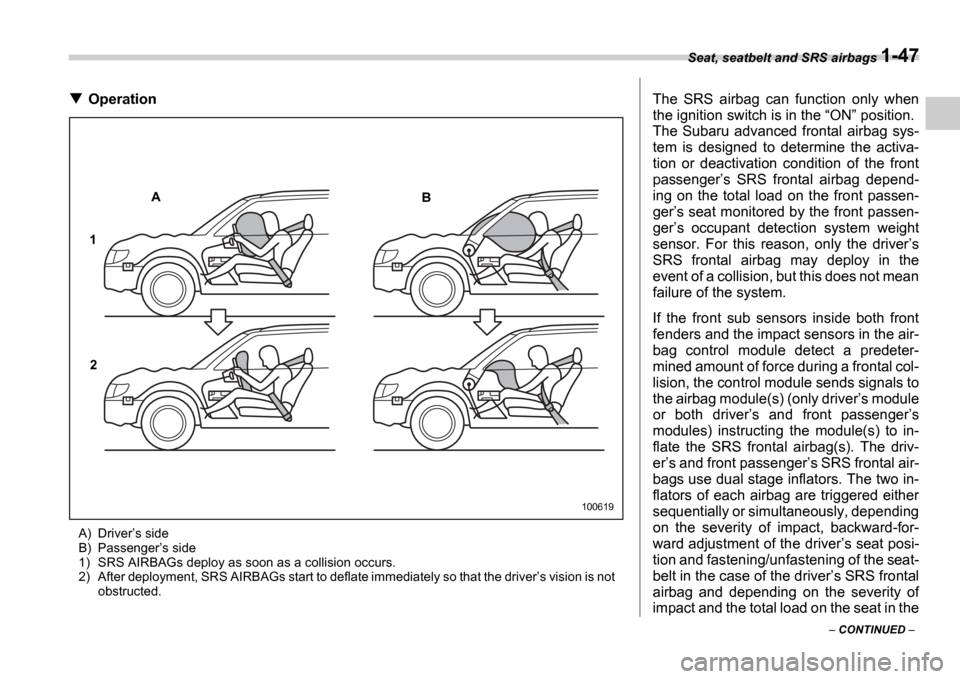
Seat, seatbelt and SRS airbags 1-47
CONTINUED
Operation
A) Drivers side
B) Passenger s side
1) SRS AIRBAGs deploy as soon as a collision occurs.
2) After deployment, SRS AIRBAGs start to deflate im mediately so that the drivers vision is not
obstructed.
A B
1
2
100619
The SRS airbag can function only when
the ignition switch is in the ON position.
The Subaru advanced frontal airbag sys-
tem is designed to determine the activa-
tion or deactivation condition of the front
passenger s SRS frontal airbag depend-
ing on the total load on the front passen-
ger s seat monitored by the front passen-
ger s occupant detection system weight
sensor. For this reason, only the driver s
SRS frontal airbag may deploy in the
event of a collision, but this does not mean
failure of the system.
If the front sub sensors inside both front
fenders and the impact sensors in the air-
bag control module detect a predeter-
mined amount of force during a frontal col-
lision, the control module sends signals to
the airbag module(s) (only driver s module
or both driver s and front passenger s
modules) instructing the module(s) to in-
flate the SRS frontal airbag(s). The driv-
er s and front passenger s SRS frontal air-
bags use dual stage inflators. The two in-
flators of each airbag are triggered either
sequentially or simultaneously, depending
on the severity of impact, backward-for-
ward adjustment of the driver s seat posi-
tion and fastening/unfastening of the seat-
belt in the case of the driver s SRS frontal
airbag and depending on the severity of
impact and the total load on the seat in the
Page 84 of 365
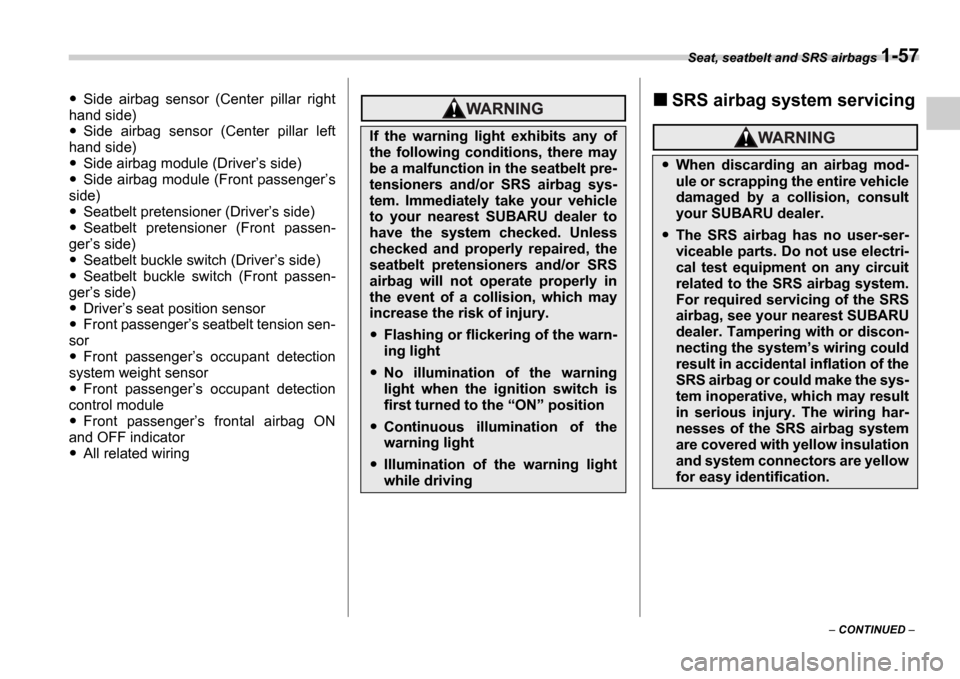
Seat, seatbelt and SRS airbags 1-57
CONTINUED
Side airbag sensor (Center pillar right
hand side)
Side airbag sensor (Center pillar left
hand side)
Side airbag module (Driver s side)
Side airbag module (Front passenger s
side)
Seatbelt pretensioner (Driver s side)
Seatbelt pretensioner (Front passen-
ger s side)
Seatbelt buckle switch (Driver s side)
Seatbelt buckle switch (Front passen-
ger s side)
Driver s seat position sensor
Front passenger s seatbelt tension sen-
sor
Front passenger s occupant detection
system weight sensor
Front passenger s occupant detection
control module
Front passenger s frontal airbag ON
and OFF indicator
All related wiring
SRS airbag system servicing
If the warning light exhibits any of
the following conditions, there may
be a malfunction in the seatbelt pre-
tensioners and/or SRS airbag sys-
tem. Immediately take your vehicle
to your nearest SUBARU dealer to
have the system checked. Unless
checked and properly repaired, the
seatbelt pretensioners and/or SRS
airbag will not operate properly in
the event of a collision, which may
increase the risk of injury.
Flashing or flickering of the warn-
ing light
No illumination of the warning
light when the ignition switch is
first turned to the ON position
Continuous illumination of the
warning light
Illumination of the warning light
while driving
When discarding an airbag mod-
ule or scrapping the entire vehicle
damaged by a collision, consult
your SUBARU dealer.
The SRS airbag has no user-ser-
viceable parts. Do not use electri-
cal test equipment on any circuit
related to the SRS airbag system.
For required servicing of the SRS
airbag, see your nearest SUBARU
dealer. Tampering with or discon-
necting the system s wiring could
result in accidental inflation of the
SRS airbag or could make the sys-
tem inoperative, which may result
in serious injury. The wiring har-
nesses of the SRS airbag system
are covered with yellow insulation
and system connectors are yellow
for easy identification.
Page 90 of 365

Keys and doors 2-3
CONTINUED
Immobilizer (Turbo models)
The immobilizer system is designed to
prevent an unauthorized person from
starting the engine. Only keys registered
with your vehicle s immobilizer system
can be used to operate your vehicle. Even
if an unregistered key fits into the ignition
switch and can be turned to the START
position, the engine will automatically stop
after several seconds.
Each immobilizer key contains a tran-
sponder in which the key s ID code is
stored. When a key is inserted into the ig-
nition switch and turned to the ON posi-
tion, the transponder transmits the key s
ID code to the immobilizer system s re-
ceiver. If the transmitted ID code matches
the ID code registered in the immobilizer
system, the system allows the engine to
be started. Since the ID code is transmit-
ted and acted upon almost instantly, the
immobilizer system does not impede nor-
mal starting of the engine.
If the engine fails to start, pull out the key
once before trying again. (Refer to the Ig-
nition switch section [chapter 3].)
This device complies with Part 15 of
the FCC Rules and with RSS-210 of In-
dustry Canada. Operation is subject to
the following two conditions: (1) This device may not cause harmful interfer-
ence, and (2) this device must accept
any interference received, including in-
terference that may cause undesired
operation.
Changes or modifications not express-
ly approved by the party responsible
for compliance could void the user
s
authority to operate the equipment.
NOTE
To protect your vehicle from theft,
please pay close attention to the fol-
lowing security precautions:
Never leave your vehicle unattended
with its keys inside.
Before leaving your vehicle, close all
windows and lock the doors and rear
gate.
Do not leave spare keys or any
record of your key number in the vehi-
cle.
Security ID plate
1) Key number plate
2) Security ID plate
The security ID is stamped on the metal
plate attached to the key set. Write down
the security ID and keep it in another safe
place, not in the vehicle. This number is
needed to make a replacement key if you
lose your key or lock it inside the vehicle.
This number is also needed for replace-
ment or repair of the engine control unit,
immobilizer control unit.
Security indicator light
The security indicator light deters potential
thieves by indicating that the vehicle is
equipped with an immobilizer system. It
Do not place the key under direct
sunlight or anywhere it may be-
come hot.
Do not get the key wet. If the key
gets wet, wipe it dry with a cloth
immediately.
1 2
200803
Page 128 of 365
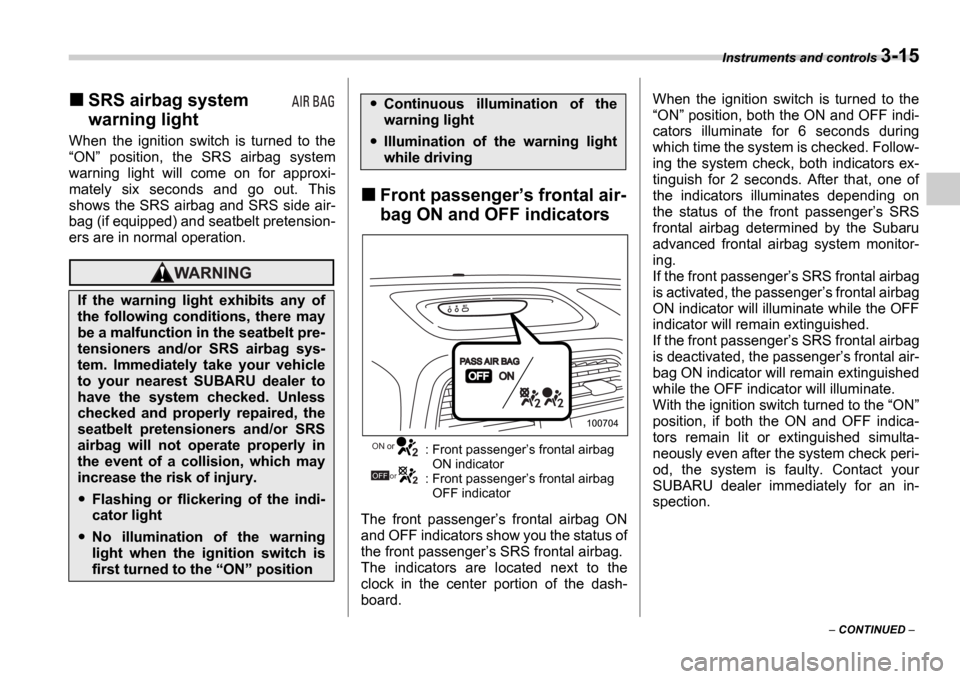
Instruments and controls 3-15
CONTINUED
SRS airbag system
warning light
When the ignition switch is turned to the ON position, the SRS airbag system
warning light will come on for approxi-
mately six seconds and go out. This
shows the SRS airbag and SRS side air-
bag (if equipped) and seatbelt pretension-
ers are in normal operation.
Front passenger s frontal air-
bag ON and OFF indicators
: Front passenger s frontal airbag
ON indicator
: Front passenger s frontal airbag
OFF indicator
The front passenger s frontal airbag ON
and OFF indicators show you the status of
the front passenger s SRS frontal airbag.
The indicators are located next to the
clock in the center portion of the dash-
board. When the ignition switch is turned to the
ON position, both the ON and OFF indi-
cators illuminate for 6 seconds during
which time the system is checked. Follow-
ing the system check, both indicators ex-
tinguish for 2 seconds. After that, one of
the indicators illuminates depending on
the status of the front passenger s SRS
frontal airbag determined by the Subaru
advanced frontal airbag system monitor-
ing.
If the front passenger s SRS frontal airbag
is activated, the passenger s frontal airbag
ON indicator will illuminate while the OFF
indicator will remain extinguished.
If the front passenger s SRS frontal airbag
is deactivated, the passenger s frontal air-
bag ON indicator will remain extinguished
while the OFF indicator will illuminate.
With the ignition switch turned to the ON
position, if both the ON and OFF indica-
tors remain lit or extinguished simulta-
neously even after the system check peri-
od, the system is faulty. Contact your
SUBARU dealer immediately for an in-
spection.
If the warning light exhibits any of
the following conditions, there may
be a malfunction in the seatbelt pre-
tensioners and/or SRS airbag sys-
tem. Immediately take your vehicle
to your nearest SUBARU dealer to
have the system checked. Unless
checked and properly repaired, the
seatbelt pretensioners and/or SRS
airbag will not operate properly in
the event of a collision, which may
increase the risk of injury.
Flashing or flickering of the indi-
cator light
No illumination of the warning
light when the ignition switch is
first turned to the ON position
Continuous illumination of the
warning light
Illumination of the warning light
while driving
100704
ON or
OFF or